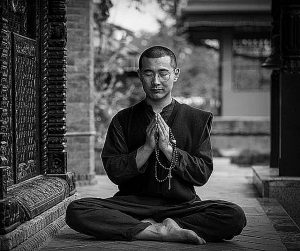Differences Between Meditation and Prayer: Throughout human history, prayer and meditation have both been vital arts. Both are employed in the quest for profound tranquility, connection with the uncharted regions of the human soul, and the experience of ultimate purpose even in the most trying circumstances.
We’ll explore these distinctions between prayer and meditation and highlight their unique characteristics to clarify what each practice is and implies. At first look, some of the points might even seem to conflict with one another, but these tensions are required to clarify each practice and paint a more vivid image of their distinctions.
Recommended: Oldest Buildings from Around the World
What is prayer?
People who practice religion view prayer as an important aspect of their life. They view prayer as a means of communicating their praise and ideas to God. Some people pray to feel connected to God and to channel their energy toward him.

There are seemingly countless prayers in most religions, ranging from asking for forgiveness to healing the ill. Islam, for instance, mandates five times a day of prayer to thank Allah; Christian and Jewish prayers also have comparable intentions. A prayer is a tool used by religious individuals to develop a stronger relationship with God.
Also see: How to Know You Are Destined For Greatness
What is meditation?
However, during meditation, there is no contact with a higher force. The goal is for you to connect with yourself instead. You concentrate inward, pay attention to your breathing, and choose to sit quietly rather than speak aloud what’s on your mind. There is no connection between meditation and God or any other being; it is a purely personal practice that helps one achieve a condition of spiritual clarity.

The idea that meditation reduces stress, anxiety, and unhappiness is supported by evidence. The most well-known type of meditation, referred to as “mindfulness meditation,” just necessitates that you sit motionless for around ten min, keep your eyes closed, and focus entirely on your breathing. Continue to breathe anytime you become aware of your mind straying.
You might believe that there are no distinctions between meditation and prayer. Both need you to isolate yourself in a serene environment, close your eyes, and concentrate. However, each has special advantages and differences of its own.
But there are similarities between meditation and prayer. Both are employed as techniques for self-reflection and raising awareness. Both strategies emphasize clearing the mind of distracting ideas and energies. Both are techniques for focusing on oneself while oblivious to your environment. There are good reasons why meditation or prayer are included in the practices of practically all religions and faiths. You can establish a stable connection with either yourself or God through both meditation and prayer.

Also see: Difference Between Federal and State Government
Differences Between Meditation and Prayer
1. Prayer goes outward. Meditation goes inward: You look for a connection with something or someone outside of yourself when you pray. Usually, this person is a god or a form of spiritual advisor. You connect with yourself through meditation, with your inner wisdom or intuition.

Although you don’t need to speak, you can be repeating a chant if it will assist. All feelings of sorrow for the past and fear for the future disappear. You are now only left with your current ideas, feelings, and sensations.
2. Prayer depends on religious faith. Meditation does not: You approach external deities or supernatural beings during prayer. So, having faith in those beings is a requirement for praying. Remove faith in any external leader or helper, and you remove the motivation for prayer.

It is not necessary to believe in a personal God or other helpful spiritual to meditate. Instead of receiving advice from other minds, you are using your inner knowledge and wisdom.
Also see: Advantages And Disadvantages Of Oral Communication
3. Prayer is considered a requirement for some religions. Meditation is not: Prayer is viewed as necessary in many religions. Religious believers who hold their faith seriously are expected to do this. Devotion in the eyes of a believer is prayer (and vice-versa). Although it is not necessary for anybody to meditate, those who do so regularly experience nothing but obvious benefits.

4. Prayer teaches the duality of God and believer; meditation teaches oneness: Two people are conversing with each other while praying. One is all there is in meditation. The relationship you’re attempting to establish through prayer depends on the dual nature between God and the believer.
The connection between you and your inner guidance during meditation is crucial for cultivating a listening, accepting, and self-loving attitude. By practicing this mindset toward yourself, you improve your ability to understand, accept, and love others.
Also see: Advantages And Disadvantages Of Being In A Relationship
5. Prayer teaches childlike submission toward God; meditation does not: When you pray, you take on a role of submission, just as you would as a kid or a student before a teacher. Contrarily, meditation doesn’t necessitate a capitulation mentality. You are among them if you consider a spiritual being to be both greater than and a part of oneself. You do this in a way that extends their love and wisdom, not as a supplicant.
6. Prayer is speaking. Meditation is listening: When you pray, you are conversing with someone. You are speaking to a spiritual being that is outside of and more magnificent than yourself by using your own words or prayers that have been composed by others.
When you meditate, you pay attention to your thoughts and feelings as they arise in your mind and heart. Additionally, you pay attention to your physical well-being as well as environmental cues. Words are inconsequential.
Also see: How To Be An Intelligent Student at School
7. Prayer involves movement. Meditation is about stillness: Although you’re not compelled to, you might adopt a particular posture for meditation. Moving during meditation is not necessary. Prayer frequently entails particular body positions (the most popular being prostration as well as kneeling), hand motions, and an elevation of the head to heaven. Christians contend that your prayer life affects your worldview. The way you move and hold your body during prayer is just as important as what you say.
8. Prayer is asking. Meditation is accepting: Typically, when you pray, you are pleading with God for something you already possess or for it to exist (or not happen). You’re asking for something that you want. Increasing your awareness of everything going on inside of you and in the current moment is the basic objective of meditation. Since thoughts also come and go without your control, meditation aims to accept passing thoughts and emotions without passing judgment on them.
Also see: Advantages and Disadvantages of Written Communication
9. Prayer is relational. Meditation is individual: A relationship exists between the person praying and the person being prayed for. The intention is to strengthen that bond to promote trust, candor, and youthful audacity. Aside from the bond, you have with yourself, meditation is an individual experience. Having said that, meditating regularly can enhance all of your relationships.
10. Prayer addresses the past, present, and future. Meditation is present-focused: Praying affects the past, now, and future. You can beg for a blessing in the future, confess a previous sin, or comment on a current event. During meditation, your attention is solely on the current moment, including all of your thoughts, feelings, and sensations. It doesn’t consider the past again or the future. The current reality is the only reality.
Recommended: Countries with the highest number of youth population
Conclusion
Both prayer and meditation are acts of devotion even by themselves. Since they are so closely related, it is simple to see how they could be used as two separate practices with the same goal—peace, and wholeness—or as two facets of the same concept. The aforementioned ideas are more like tendencies that highlight the distinctions between prayer and meditation than they are absolute realities.

Edeh Samuel Chukwuemeka, ACMC, is a lawyer and a certified mediator/conciliator in Nigeria. He is also a developer with knowledge in various programming languages. Samuel is determined to leverage his skills in technology, SEO, and legal practice to revolutionize the legal profession worldwide by creating web and mobile applications that simplify legal research. Sam is also passionate about educating and providing valuable information to people.